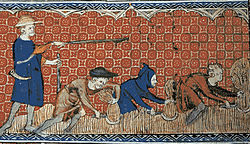Contents
- Symbols
- Observances
- Non-Gregorian: 2025 dates
- Month-long
- Moveable Gregorian
- Fixed Gregorian
- References
- External links
| << | August | >> | ||||
|---|---|---|---|---|---|---|
| Su | Mo | Tu | We | Th | Fr | Sa |
| 1 | 2 | |||||
| 3 | 4 | 5 | 6 | 7 | 8 | 9 |
| 10 | 11 | 12 | 13 | 14 | 15 | 16 |
| 17 | 18 | 19 | 20 | 21 | 22 | 23 |
| 24 | 25 | 26 | 27 | 28 | 29 | 30 |
| 31 | ||||||
| 2025 | ||||||


August is the eighth month of the year in the Julian and Gregorian calendars. Its length is 31 days. [2]
In the Southern Hemisphere, August is the seasonal equivalent of February in the Northern Hemisphere. In the Northern Hemisphere, August falls in summer. In the Southern Hemisphere, the month falls during winter. In many European countries, August is the holiday month for most workers. Numerous religious holidays occurred during August in ancient Rome. [3]
Certain meteor showers take place in August. The Kappa Cygnids occur in August, with yearly dates varying. The Alpha Capricornids meteor shower occurs as early as July 10 and ends around August 10. The Southern Delta Aquariids occur from mid-July to mid-August, with the peak usually around July 28–29. The Perseids, a major meteor shower, typically takes place between July 17 and August 24, with the peak days varying yearly. The star cluster of Messier 30 is best observed around August.
Among the aborigines of the Canary Islands, especially among the Guanches of Tenerife, the month of August received the name of Beñesmer or Beñesmen, which was also the harvest festival held that month. [4] [5]
The month was originally named Sextilis in Latin because it was the 6th month in the original ten-month Roman calendar under Romulus in 753 BC, with March being the first month of the year. About 700 BC, it became the eighth month when January and February were added to the year before March by King Numa Pompilius, who also gave it 29 days. Julius Caesar added two days when he created the Julian calendar in 46 BC ( AUC 708), giving it its modern length of 31 days.
In 8 BC, the month was renamed in honor of Emperor Augustus. [6] According to a Senatus consultum quoted by Macrobius, he chose this month because it was the time of several of his great triumphs, including the conquest of Egypt. [7] Commonly repeated lore has it that August has 31 days because Augustus wanted his month to match the length of Julius Caesar's July, but this is an invention of the 13th century scholar Johannes de Sacrobosco. Sextilis had 31 days before it was renamed. It was not chosen for its length. [8] [9]



